This spring, I got a little seed starter pot as freebie from that gardening bundle I participated in.
(I just had to pay for shipping, which for me was $10, coming to the east coast from California.)
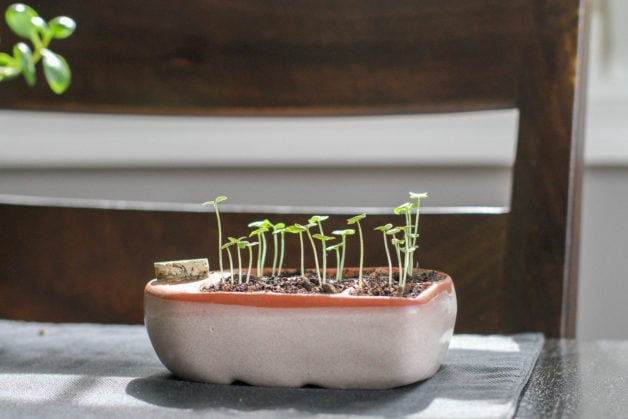
The free one is a factory-second, and that appeals to my waste-avoiding heart; I’m delighted to give a home to a less-than-perfect item at a discount.
I’ve posted photos of my little pot on social media and I keep getting questions about it, so I figured a little review post would be helpful.
What’s a self-watering pot?
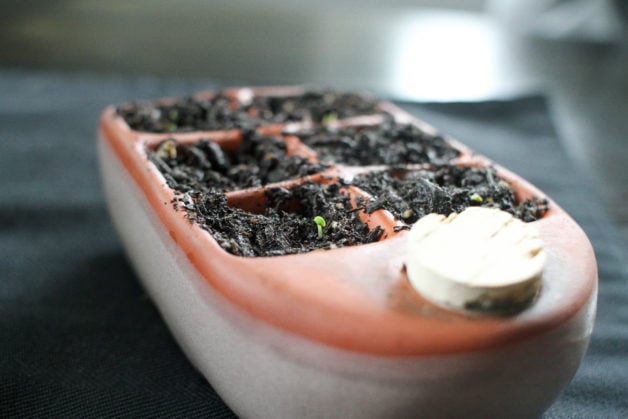
This little pot is made of terracotta and there’s a reservoir underneath the plants. The terracotta absorbs the water from the reservoir and keeps the dirt around the seedlings consistently moist, but not too wet.
Does it work?
Most definitely! I’ve been very impressed with how evenly wet the dirt has stayed. As soon as the water is gone, the dirt dries up.
But as long as the reservoir has water, all is well.
If you’ve had trouble getting seeds to germinate, I think this pot would probably solve your problem.
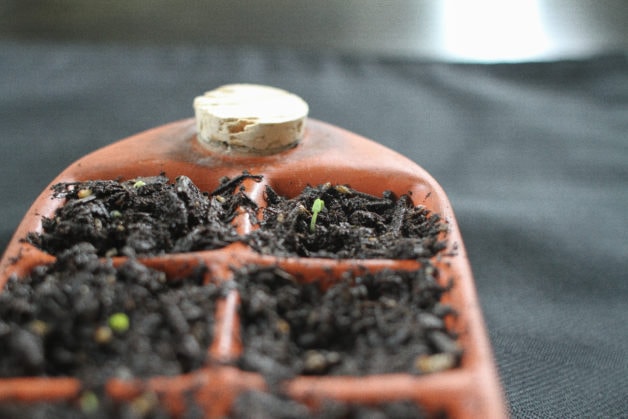
What are the pros of the Orta seed starter pot?
- It’s plastic-free (it even ships with plastic-free packaging)
- It’s made by a small company
- It looks more beautiful than typical plastic seed-starter pots (I’m happy to have it on my dining room table!)
- You don’t have to regularly water your seedlings
- It’s durable and can be used over and over
What are the cons?
I really can only think of one which is: the price.
A no-flaws version of what I have costs $43! That’s a whole lot more expensive than pretty much every other seed starting option out there.
And while this is plastic free, it’s not like plastic pots are not the only seed-starting option; you can use peat pots, which are compostable, or you could even start your seeds in egg cartons, which can also just decompose into the soil.
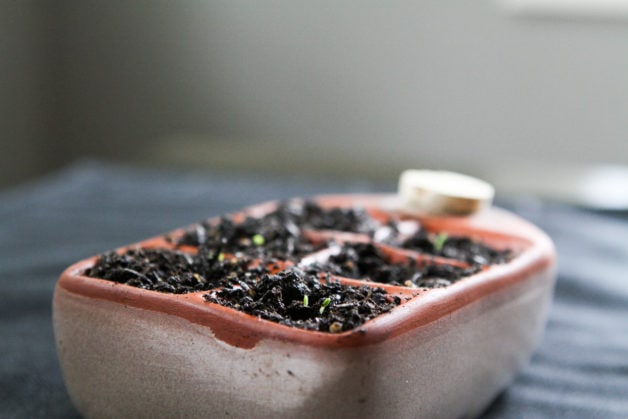
Who should buy one of these?
Well.
I obviously do not think this is a good fit for experienced, super-frugal gardeners.
But if you are a person who will not start seedlings unless it’s super-duper easy to do, then this might be worth it.
I’m pretty certain that the little basil seedlings I’ve started will produce well over $43 of basil this summer.
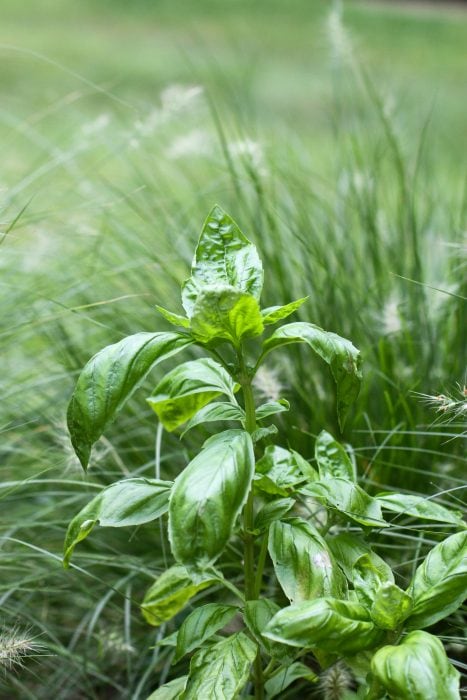
So, if this little starter gets you over the hump of putting some seeds into the dirt, I’d say go for it.
I also think that the seed starter pot could make a fun gift for a new-ish gardener.
I know that when I buy gifts, I often am much more willing to spend above the bare minimum; I wouldn’t give egg carton seed starters as a gift, but I would definitely give this to the right person.
And if you are very interested in supporting a small, eco-friendly business, then I could see why you might want to buy an Orta pot.
A side-note about pricing
This probably could be a whole post in and of itself, but I find it interesting that everyone in my house (including me) was like, “Whoa! $43 for a seed pot is so much!”
But how many times over have we spent $43 on consumable things such as coffee or takeout or movie tickets, and thought almost nothing of it?
This is really not very logical; a reusable plant pot, which can produce plants, which can produce food for months is somehow too expensive at $43, but takeout or a streaming service is not too expensive at $43?
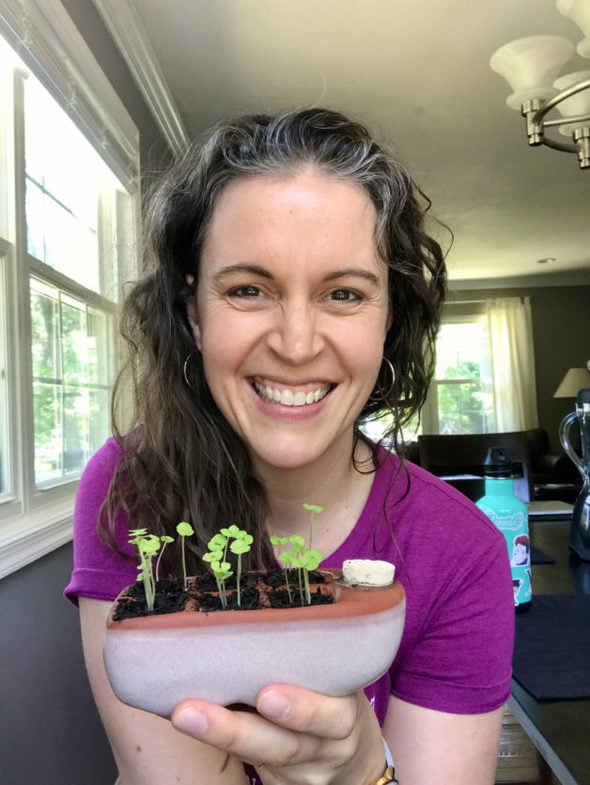
Anyway!
I personally will probably not get another Orta pot for my own use.
But I will definitely consider giving one as a gift in the future. And I would feel no judgement toward someone who wanted to buy one of these for themselves.
A flash sale starts tomorrow
(well, tonight at midnight is more accurate)
The gardening bundle, which is where I got my seed starter for free, is available through Friday at midnight.
So, if you’d like to get:
- the Orta seed pot (just pay shipping)
- my 4-week food waste course
- 24 other courses/ebooks
- several other bonus offers
for a total of $24.97, click here to get your bundle.
Is $24.97 a good price?
Well, my food waste course regularly sells for $49.00, and if you implement the things I teach, you could save about $1800/year.
So, for that alone, the bundle is worth the price.
And if you’d like the seed pot, either for yourself or for a gift (Christmas will come sooner than you think!), that really makes the bundle worth it.

Rebecca in MD
Thursday 29th of July 2021
I use the Jiffy Peat Pellets to start my seedlings and then when they develop true leaves I move them up to Cow Pots with special potting soil for seedlings. The Cow Pots are made from recycled cow manure and can be planted in the ground to gradually break down while feeding the plant. This system with my HydroFarm grow lights has been very successful, and I grow many varieties of tomatoes, peppers, herbs, and flowers from seed every year.
Katy in Africa
Thursday 29th of July 2021
We were told by someone with more experience than us to start seed in a bag with a wet paper towel. We tried it and some took, but not all. We then transfered the to smaal plastic bag of dirt. The bags are sold with drinking water in them, we've collected used ones. Now I think our plants are ready to go in the ground, but we'll take them out of the bags.
Emily Fields
Thursday 29th of July 2021
As soon as I saw this pot I thought “this is perfect for moms with littles.” Or homeschooling families, for that matter, just as an “educational” center piece. I’m definitely imagining some great dinner conversations as we watch seedlings grow! Thanks for sharing, I’m gonna get the bundle!
Jackie
Wednesday 28th of July 2021
I keep seeds from my garden year to year. I place them on a paper towel and let them dry. Then I put them dried on the paper towel in a ziploc bag and seal it. Then in March, I add a little water to dampen the paper towel and seal the sandwich baggie and place somewhere warm. When the seeds sprout, I move them to an egg carton. My grandmother, mother, and who knows how many of my family do this. I can and freeze almost all fruits and veggies my family eats. My family teases me that I am a 1940s farmers wife who was born about sixty years too late!
Lindsey
Wednesday 28th of July 2021
I use all manner of plastic discards--cottage cheese containers, clam shells from grocery store purchases, and so on. The only time I purchased commercial plastic seed starting equipment was a 10 pack of extra heavy duty plastic flats that each had 72 cells in them. I plant hundreds of leeks every year and leeks will survive in the small cells and do okay at transplanting because you can trim not only their roots but their tops and they do fine. Other seedlings would not make it in those small cells. I have used toilet paper rolls and made my own newspaper pots, but they disintegrate quickly and some of my transplants need to spend 6 to 8 weeks indoors before I transplant them, so I no longer use them. The egg shell idea is okay but only for plants that are going to be transplanted into larger homes or the garden soon after their first true leaves develop; there is not enough soil and not enough nutrients to keep them in the shells for weeks at a time. Really, between the plastic containers I save all year long and four or six packs I get and save when I buy my yearly petunias (I cannot seem to grow those well from seed, no matter what), I don't need to spend money on seed starting flats. When I worked in a regular office, I let people know I wanted their yogurt, cottage cheese and so on castoffs and I was inundated with containers. A number of people told me they were thrilled to have a way to recycle them and began saving them year around for me.